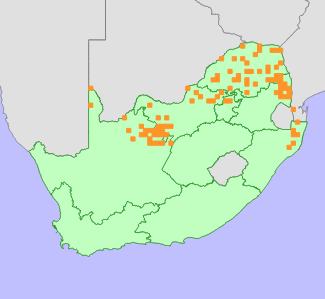| Scientific Name | Heliotropium strigosum Willd. | Higher Classification | Dicotyledons | Family | BORAGINACEAE | Synonyms | Heliotropium constrictum Kaplan | Common Names | Single Star (e) |
National Status | Status and Criteria | Least Concern | Assessment Date | 2017/09/05 | Assessor(s) | L. von Staden | Justification | Heliotropium strigosum is widespread, common and not in danger of extinction. |
Distribution | Endemism | Not endemic to South Africa | Provincial distribution | Gauteng, KwaZulu-Natal, Limpopo, Mpumalanga, Northern Cape, North West | Range | This species is widespread across northern and eastern South Africa, extending throughout tropical Africa as far as the Arabian Peninsula. |
Habitat and Ecology | Major system | Terrestrial | Major habitats | Granite Lowveld, Ghaap Plateau Vaalbosveld, Kuruman Mountain Bushveld, Kuruman Thornveld, Polokwane Plateau Bushveld, Gabbro Grassy Bushveld, Limpopo Sweet Bushveld, Waterberg Mountain Bushveld, Central Sandy Bushveld, Phalaborwa-Timbavati Mopaneveld, Makhado Sweet Bushveld, Soutpansberg Mountain Bushveld, Schmidtsdrif Thornveld, Marikana Thornveld, Mafikeng Bushveld, Southern Kalahari Mekgacha, Koranna-Langeberg Mountain Bushveld, Kimberley Thornveld, Kuruman Vaalbosveld, Zeerust Thornveld, Nwambyia-Pumbe Sandy Bushveld, Pretoriuskop Sour Bushveld, Lowveld Rugged Mopaneveld, Northern Lebombo Bushveld, Stella Bushveld, Southern Lebombo Bushveld, Tsende Mopaneveld, Musina Mopane Bushveld, Western Maputaland Clay Bushveld, Limpopo Ridge Bushveld, Roodeberg Bushveld, Gravelotte Rocky Bushveld, Springbokvlakte Thornveld, Sekhukhune Mountain Bushveld, Dwaalboom Thornveld, Western Sandy Bushveld, Tshokwane-Hlane Basalt Lowveld, Zululand Lowveld, Sekhukhune Plains Bushveld, Makuleke Sandy Bushveld, Dwarsberg-Swartruggens Mountain Bushveld, Western Maputaland Sandy Bushveld, Tembe Sandy Bushveld, Kathu Bushveld, Subtropical Alluvial Vegetation, Mopane Gabbro Shrubland, Mamabolo Mountain Bushveld | Description | It occurs in open woodlands and grasslands on shallow sandy soils, and also along roadsides and in disturbed places. |
Population | Population trend | Stable |
Assessment History |
Taxon assessed |
Status and Criteria |
Citation/Red List version | | Heliotropium strigosum Willd. | Least Concern | Raimondo et al. (2009) | |
Bibliography | Martins, E.S. 1990. Boraginanaceae. In: E. Launert and G.V. Pope (eds). Flora Zambesiaca 7 (Part 4):59-114. Flora Zambesiaca Managing Committee, London.
Raimondo, D., von Staden, L., Foden, W., Victor, J.E., Helme, N.A., Turner, R.C., Kamundi, D.A. and Manyama, P.A. 2009. Red List of South African Plants. Strelitzia 25. South African National Biodiversity Institute, Pretoria.
Retief, E. and Herman, P.P.J. 1997. Plants of the northern provinces of South Africa: keys and diagnostic characters. Strelitzia 6. National Botanical Institute, Pretoria.
Wright, C.H. 1904. Boragineae. In: W.T. Thiselton-Dyer (ed). Flora Capensis IV Section II (Hydrophyllaceae to Pedalineae):2-45. Lovell Reeve & Co., Ltd., London.
|
Citation | | von Staden, L. 2017. Heliotropium strigosum Willd. National Assessment: Red List of South African Plants version 2024.1. Accessed on 2025/11/17 |
 Comment on this assessment Comment on this assessment
|
Search for images of Heliotropium strigosum on iNaturalist
|
 Comment on this assessment
Comment on this assessment

